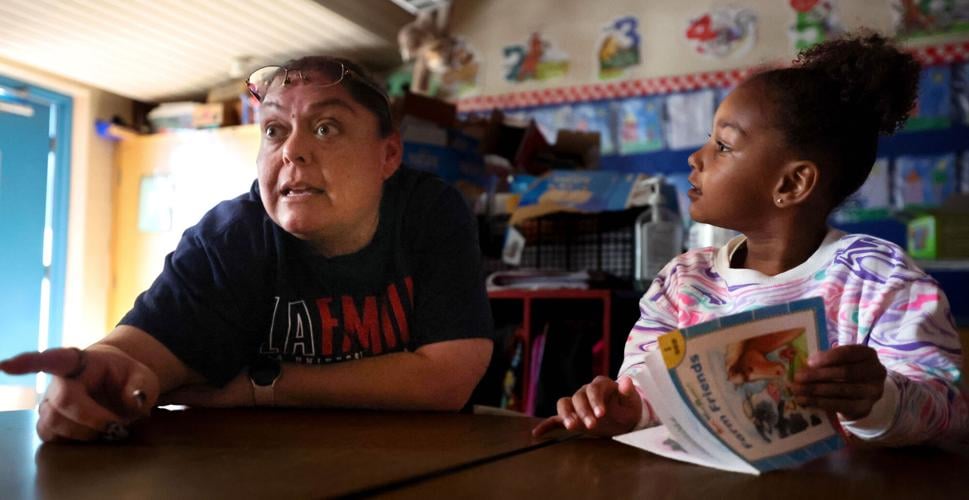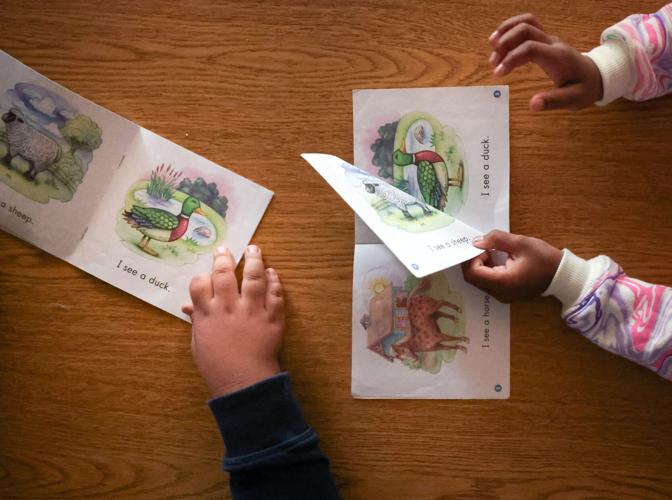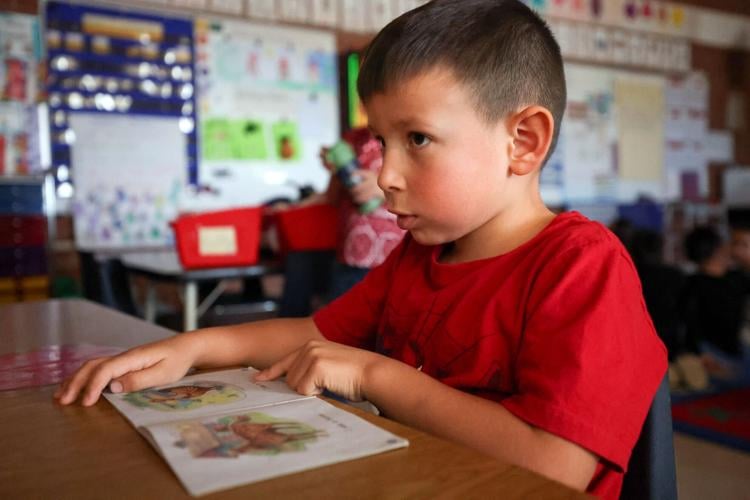On a given day in Marivel Yanez’s kindergarten class at White Elementary in Tucson, reading lessons go beyond what is in paperwork and regulations. There’s dancing, singing, clapping — and excitement.
That may change soon, as Yanez and some other educators worry new regulations on their teaching methods will dampen that joy.
In 2021 the Arizona Legislature, with all Republicans in favor and all Democrats opposed, mandated a new way to teach reading in elementary schools, prompting mixed reactions from reading professionals.
The law, which requires students to learn to read with the “Science of Reading” method, places an emphasis on phonics, where students focus on sounding out letters into words.
The change is welcomed by Tom Horne, Arizona’s superintendent of public instruction, an elected Republican.
“There’s no question that the scientific studies all show that phonics is much more successful in teaching students to read,” Horne said in an interview.
Read On Arizona director Terri Clark also referenced literacy research. Read On Arizona is the state’s early learning initiative. She said research leading to the Science of Reading concept began before the pandemic.
“We have case studies that we’ve done to highlight: what are the approaches that (successful) schools have done, that other schools who might have similar demographics can learn from them, but it feels like we’ve really helped shape what Science of Reading is based on data and demonstrated results, not just theory or an idea.”
The National Center on Improving Literacy, an organization that advocates “evidence-based resources for improving outcomes for students with literacy-related disabilities,” breaks down the Science of Reading into five elements: phonemic awareness (identifying and playing with sounds in spoken words), phonics (instruction on understanding how letters and groups of letters link to form letter-sound relationships and spelling patterns), reading fluency, vocabulary and comprehension.
“In a nutshell,” Clark said, “It’s a body of evidence over multiple decades that points to what works as far as teaching reading.”
‘Shouldn’t be one size fits all’
Still, some experts say there are shortcomings to relying solely on the science of reading. Kathy Short, a professor in the college of education at the University of Arizona, hit back against Horne’s claims. Short said the research only supports the Science of Reading policy “if you throw out 90% of the research in the field.”
“Those claims are based on a very, very small number of students,” she added.
Short isn’t alone in her concerns about the new policy.
“The Science of Reading has created a reading crisis in this country,” said Carol Brochin, another professor in the college of education at the UA. “It focuses on a Band-Aid solution instead of focusing on other cultural (and) social factors.”
The UA teaching education program does teach phonics, a key part of science of reading, in their classes. The difference is that they used to be able to teach other methods too, which is important, Short said.
There used to be a bigger emphasis on understanding sociocultural differences, and a greater focus on reading comprehension, Short said.
“There’s also a lot of time needed for understanding reading comprehension itself,” she said. “Also more time needed on the range of tools and strategies that readers need in order to do word recognition. Now we won’t have that.”
Yanez, at Tucson Unified School District’s White Elementary, said she has taught many English language learners. “Every child is different,” she said. “In my class right now, I have 26 kids. All 26 have a different way of learning.”
Brochin said the Science of Reading is a one-size-fits-all approach to a much more complex issue, and that the new way of teaching could impact the number of teachers in the future.
“I really see this as a larger attack on teachers across the country,” she said. “Teaching children how to read should never be one size fits all.”
Yanez incorporates kinesthetics, music, word/picture recognition and other methods into her instruction. She has taught kindergarten for 13 years.
The Science of Reading concept isn’t entirely different from what educators are doing at Flowing Wells Unified School District, said Flowing Wells’ district reading specialist Jennifer DeFilippis. DeFilippis’s role is to coach teachers in reading instruction, observe classrooms and provide special reading help groups for students.
“We are always responding to research and always looking to, what is the research telling us?” DeFilippis said. “We were able to not have a complete overhaul (because of the mandate). We were really confident in our system.”
Concerns about mandates
However, more requirements can place an extra burden on those who teach the teachers.
DeFilippis said reading instruction practices move quickly. At Flowing Wells, teachers are offered training opportunities to keep up with research and requirements.
Sometimes requirements don’t allow enough time for adjustment, said Pima County School Superintendent Dustin Williams.
“We need flexible timelines and consistent timelines for schools to operate. Once we start some of these ideas … there has to be continued support for the idea and it has to be consistent. We can’t just up and stop something or or we want to redirect funds.
“When you see the new mandates come through, and there tends to be more and more, the concern is, there’s not a lot of funding behind the mandate,” he said.
The Science of Reading instructional mandates are effective in 2025.
Brochin, who teaches teacher education courses at the UA, had to go through her syllabi and adapt her courses to meet the new legal requirements. The process, she said, took her “hours upon hours.”
To teach something to her students that she is fundamentally against has been a challenge.
“I had to go through both syllabi and adapt my course to meet the legal requirements and it took me hours upon hours,” Brochin said. “The revisions have made the course not comprehensive of the principles and best practices in teaching reading.”
She added that teaching the new policy is a “disservice,” since professors are not able to “prepare them to work in classrooms with all kinds of families and all kinds of students.”
But Clark, of Read On Arizona, said part of the focus of Arizona’s mandate was making training requirements as equitable for educators as possible.
“When I see and hear teachers who have had a chance to get this kind of support and training, the way they talk about Science of Reading, it reignites their spark and their passion for why they became a teacher,” she said.
However, Williams said mandates are not necessarily the route to take.
“Teachers have to do whatever they can to make sure a student is getting taught,” he said, adding that mandates often “take tools away” from educators.
Yanez said she has talked to lawmakers about regulating instruction before.
“I told some of my legislators, come to my class for a day. I’ll give you all the lesson plans. I’ll give you everything,” Yanez said. “Then you can tell me how well that law you just put into effect is going to work.”
Horne says critics are “behind the times”
Superintendent Horne said it “reflects badly” on teachers and professors who don’t believe in the new policy.
“They ought to be teaching something else,” Horne said.
He added that the teaching professors at the UA who are against the policy are “notorious for being behind the times and sticking to an old theory that has failed.”
Yanez said, “Teachers, as the experts, are going to know. Our legislators don’t think we know anything.”
Williams said educators are sometimes left wondering, “Has anyone even asked me what I think about (state policies) being that I spend hundreds of hours with your child every day?”
Yanez has 20 years of teaching experience under her belt. She said that over the course of her decades-long career, there seems to be a reading instruction cycle.
“One thing I’ve learned in education is that everything recycles itself. Like reading; we start off with just phonics, and then they go, no that’s not working. So we (try) a different strategy. No, that didn’t work. Let’s try this strategy.”
There is one thing that is not a trend, Yanez said, and that is the joy of learning.
“You’re going over this one letter they do not get, then one day, they look at it and say, wait a minute — I know that one.
“You can just see their eyes light up and they’re so excited.”
Yanez’s students likely see it in her eyes, too.
“Oh, my God — it’s so great.”
Get your morning recap of today's local news and read the full stories here: tucne.ws/morning






